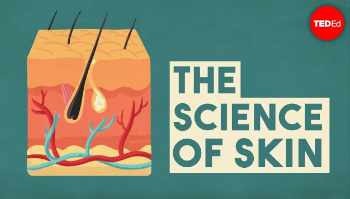(单词翻译:单击)
Between you and the rest of the world lies an interface that makes up 16% of your physical weight.
我们的身体和自然界之间有一层分界线,占体重的16%。
This is your skin, the largest organ in your body: laid out flat, it would cover close to 1.7 square meters of ground.
它就是我们身上面积最大的器官,皮肤,摊开铺平能覆盖约1.7平方米。
Its purpose may seem obvious -- to keep our insides in.
皮肤的作用显而易见--使我们的身体保持一个整体。
But a look beyond the surface reveals that it plays a surprising number of roles in our lives.
但更深入看,会发现皮肤在我们的生命中起到令人震惊的作用。
First, the basics. Skin is the foundation of the integumentary system,
首先,是基础。皮肤是表皮系统基本组成部分,
which also incorporates your hair, nails, and specialized glands and nerves.
同时还包括还包括头发、指甲、特定的腺体和神经。
Made up of three layers, the epidermis, dermis, and hypodermis,
皮肤分为3层:表皮层真皮层和皮下组织。
skin's thickness varies from 0.5 millimeters at its thinnest and up to four millimeters at its thickest.
皮肤最薄处为0.5mm,最厚处为4mm。
It also carries out three key functions: protecting, regulating, and sensing the world beyond its limits.
皮肤还具有3个关键作用:保护作用、调节作用以及对外部环境的感知作用。
On a daily basis, its huge surface processes hundreds, if not thousands, of physical sensations,
每天,我们的身体会处理成百上千次的体表感知,
relying mostly on large, pressure-sensitive skin components called Merkel cells.
主要由较大的对压力敏感的组织完成,叫做梅克尔细胞。
In your fingertips alone, there are 750 Merkel cells per each square-centimeter of skin,
在我们的指尖上,每平方厘米有750个梅克尔细胞,
coupled with over 2,500 receptors that give you your sense of touch.
以及构成触感的2500多个受体。
This surface is also the body's first major line of defense.
皮肤也是身体的第一道防线。
Without it, you'd be a soggy mass of tissue and fluids, fatally exposed to the elements.
没有皮肤,我们就是一滩组织和体液,致命的暴露于各种环境下。
Skin effectively seals off your insides
皮肤有效的将你的身体组织保持在内部,
and also absorbs pressure and shock with flexible collagen that makes up most of its dermal layer.
还能够承受外界的压力和冲击,这得益于真皮层的主要组成:具有高柔韧性的胶原蛋白。
The epidermis is made up mainly of skin cells called keratinocytes that are completely replaced every four weeks.
表皮主要由角质细胞构成,每4星期完全更新一次。
As new cells form at the base of the epidermis, older ones are pushed up.
随着新细胞在底部形成,旧细胞会被推出。
When these cells move upwards, they're filled with a hardened protein called keratin.
细胞在向上移动过程中,会被填充一种硬化的蛋白质,叫做角蛋白。
Once they reach the surface,
一旦到达表面,
they form a tightly-overlapping, waterproof layer that's difficult for invading microbes to breach.
它们会形成一层紧密重叠的防水层,使得微生物难以进入。
Any harmful microbes that make it into the epidermis will encounter Langerhans cells.
若有害微生物得以侵入,就会遇到郎格汉斯细胞。

This group of protective skin cells detects invaders
这种保护性细胞会侦测入侵者,
and communicates their presence to resident immune system T-cells, which react by launching an immune response.
并且将其报告给免疫T细胞,启动免疫反应。
A crucial feature of this immune defense is
这个免疫防卫机制的最关键一点是,
the several thousand species of microorganisms that inhabit the planes, folds, and crevices of your skin.
有数千种存在于皮肤表面、褶皱和皮肤小裂缝的微生物。
These microbes, which include bacteria and fungi, thrive in the sebum,
包括细菌和真菌的这些微生物在皮脂内十分活跃,
an oily substance that's secreted onto the skin's surface by sebaceous glands nestled inside the dermis.
由紧贴在真皮内的皮脂腺分泌到皮肤表面的油性物质。
These skin microbes keep the immune system in a state of constant surveillance,
这些皮肤微生物使得免疫系统一直处于活跃状态,
ensuring that it's ready to react if the body really is at risk.
确保在身体处于危险的情况下能够及时响应。
Beyond this protective role,
除了充当保护的角色,
your skin is also a sensory organ that helps regulate your body's temperature, two roles that are closely interlinked.
你的皮肤也是帮助调节你体温的感官,两种功能紧密相连。
Nerves detect whether your skin is warm or cold and communicate that information to your brain.
神经会检测你的皮肤是冷还是暖,并且将感知信息传达给大脑。
In return, the brain instructs localized blood vessels
反过来,大脑会对局部血管进行调节:
to either expand if the body is too warm, releasing heat from the blood through the skin,
如果身体热时扩张血管,则通过皮肤从血液释放热量,
or to constrict if the body is cold, which retains heat.
如果身体冷时则收缩血管以保留热量。
At any given time, up to 25% of the body's blood is circulating through the dermis,
在任何时间,超过25%的身体血液通过真皮循环,
making this process extremely efficient.
这使得调节体温这个过程非常有效。
Under warm conditions, the skin's sweat glands will secrete sweat via ducts onto the surface,
感到热时,皮肤的汗腺分泌的汗液将经由腺体的管道到达表面,
transferring heat out of the body.
将热量带出体外。
Hair can also be stimulated to conserve or release body warmth.
毛发也可以受刺激,保留或者释放身体的热量。
The average human has 5 million hair follicles embedded everywhere on the body
平均每个人有5百万毛囊,遍布身体每个地方,
except the palms of your hands and soles of your feet.
除了你的手掌和脚掌。
Ninety to 150,000 of those are on your scalp,
在你的头皮上有9万-15万个毛囊,
where they help shield the large surface area of your head from physical damage and sunburn.
头皮会保护很大面积的头部远离物理伤害和晒伤。
When you're cold, tiny muscles called arrector pilli cause hair to stand upright across the body.
当你冷时,叫做立毛肌的小型肌肉会使你身体的毛发竖起来。
That's the phenomenon known as goosebumps and it traps body heat close to your skin.
这种现象叫起鸡皮疙瘩,可以吸收身体附近的热量。
Skin's vast surface isn't just a shield; it also enables us to interact and connect with the world.
皮肤的巨大的表面不仅仅是一个防护盾,它还使我们与这个世界互连。
Its multifunctional layer cools us down and keeps us warm.
其多个功能层可以降温和保持体温。
The integumentary system may be many things, but it's certainly more than skin deep.
表皮系统有很多功能,它绝对不止是一层皮肤而已。


